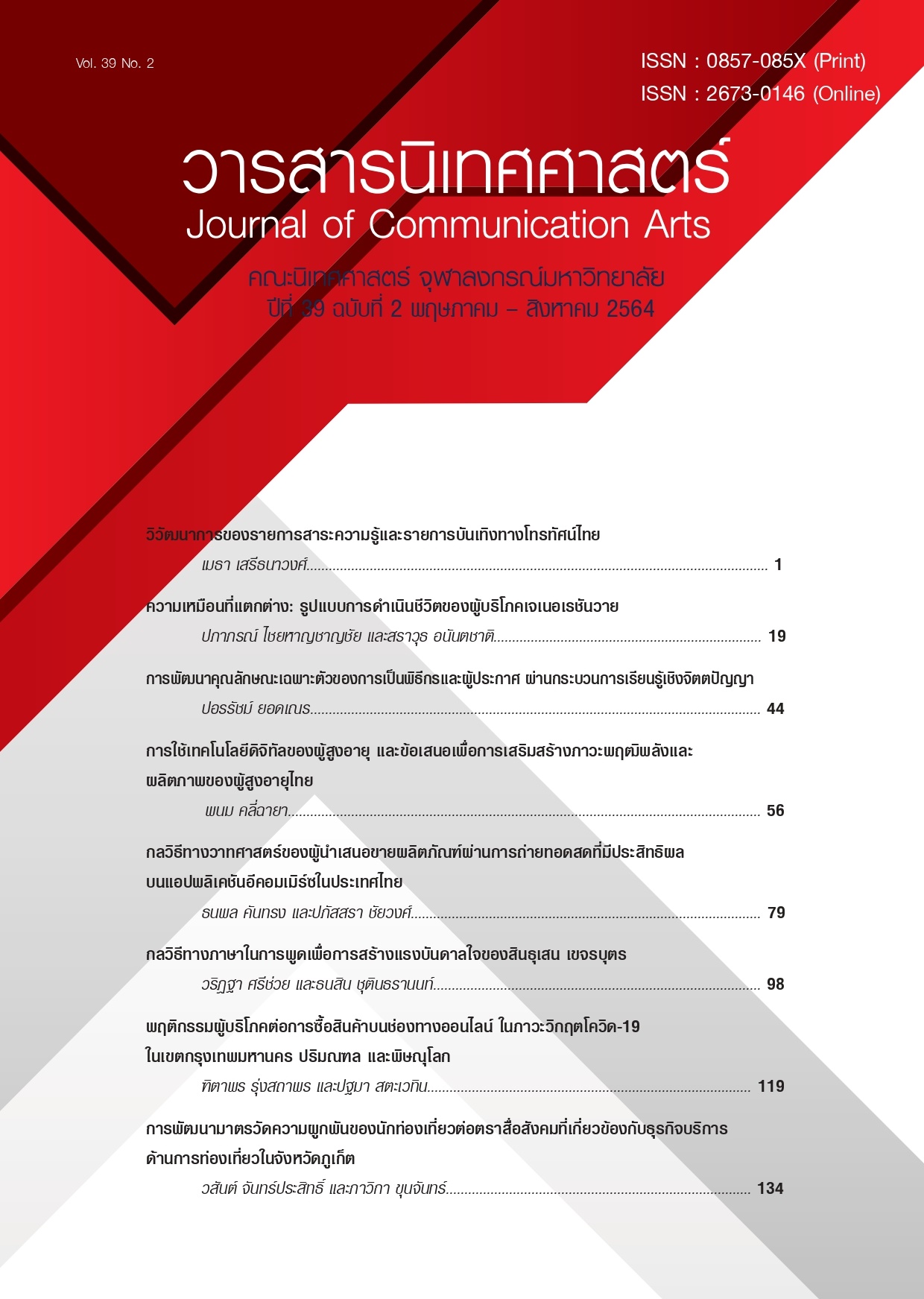Language Strategies for Inspiring Speech by Sindhusen Khaejornbut
Main Article Content
Abstract
The research methods used were of mixed methods that aim to analyze the types and characteristics of language register, also synthesize the relationships between the language register and the different contents in the inspiring speech by SINDHUSEN KHAEJORNBUT. The textual analysis and content analysis were used in this research, collected data from the content sources in 30 video clips that were published on SINDHUSEN KHAEJORNBUT’s Facebook fan page, under the name of K.S. Khunkhao. Methodological triangulation was used for accuracy and completeness of the information. the result found that the types and characteristics of the language register that SINDHUSEN KHAEJORNBUT used in the inspiring speech included data analysis and use of words categorization as the language register into 2 parts: 1) Language register according to grammar types; there were 11 types of distinctive use of word and 2) Language register according to meaning groups was divided into 6 groups. Synthesis of the relationships between the language register and the different contents in the inspiring speech by SINDHUSEN KHAEJORNBUT consisted with 2 main groups as 1) Lifestyle and 2) The human relationships which affect the way to use the language register. As mentioned above, uses of language are important for creating the identity of the speaker as an inspiration to the audiences as well as reflect the guidelines of outstanding content structure design for Sindhusen Khaejornbut’s Inspiring speech. This includes the part of the introduction the content and the summary which corresponded with the familiarity of Thai people on listening to Animal Tales that begun by scenario and ended with commentaries. Then, it would be blessing goodbye for wishing well.
Article Details

This work is licensed under a Creative Commons Attribution-NonCommercial-NoDerivatives 4.0 International License.
References
กนกรัตน์ สุขะวัฒนะ. (2534). ความสัมพันธ์ระหว่างการเปิดรับสื่อเกี่ยวกับโรคเอดส์ กับความรู้ ทัศนคติและพฤติกรรมในการป้องกันโรคเอดส์ของหญิงโสเภณี : กรณีศึกษาที่หน่วยควบคุมกามโรค อ.หาดใหญ่. (วิทยานิพนธ์ปริญญามหาบัณฑิต). มหาวิทยาลัยธรรมศาสตร์.
กาญจนา แก้วเทพ และคณะ. (2549). ใต้ฟากฟ้าแห่งการศึกษาสื่อบุคคลและเครือข่ายการสื่อสาร :ภาพรวมจากงานวิจัย. กรุงเทพมหานคร: สำนักงานกองทุนสนับสนุนการวิจัย.
เกษดา จารุรัตน์. (2557). พฤติกรรมการใช้และทัศนคติของผู้ใช้โซเชียลเน็ตเวิร์ค (SOCIAL NETWORK) กรณีศึกษา กูเกิล พลัส (GOOGLE+). กรุงเทพมหานคร: คณะนิเทศศาสตร์ มหาวิทยาลัยศรีปทุม.
คณาจารย์มหาวิทยาลัยมหาจุฬาลงกรณราชวิทยาลัย. (2553). ภาษาศาสตร์เบื้องต้น. กรุงเทพมหานคร: มหาวิทยาลัยมหาจุฬาลงกรณราชวิทยาลัย.
ดุษฎี โยเหลา, วิไลลักษณ์ ลังกา, ศรัณย์ พิมพ์ทอง และ นริสรา พึ่งโพธิ์สภ. (2556). การประเมินผลจากการชมภาพยนตร์เพื่อสร้างแรงบันดาลใจของนิสิตปริญญาตรี มหาวิทยาลัยศรีนครินทรวิโรฒ (รายงานวิจัยฉบับสมบูณ์). มหาวิทยาลัยศรีนครินทรวิโรฒ.
นววรรณ พันธุเมธา. (2559). คลังคำ. กรุงเทพมหานคร: สำนักพิมพ์อมรินทร์.
ปรมะ สตะเวทิน. (2546). หลักนิเทศศาสตร์. กรุงเทพมหานคร: คณะนิเทศศาสตร์ จุฬาลงกรณ์มหาวิทยาลัย.
ปวีณ์สุดา เหนือคลอง, ปาริชาติ แก้วนวน, พัชวรรณ ด้วงสุข, สมิทธ์ชาต์ พุมมา และ อลิสา คุ่มเคี่ยม. (2562). การใช้ภาษาในการพูดเพื่อสร้างแรงบันดาลใจของฌอน บูรณะหิรัญ. กรุงเทพมหานคร: วลัยลักษณ์วิจัย.
วรวุฒิ ภักดีบุรุษ. (2552). ศิลปะการใช้ภาษาเพื่องานนิเทศศาสตร์. กรุงเทพมหานคร: ทริปเพิ้ลเอ็ดดูเคชั่น.
สหไทย ไชยพันธุ์. (2555). แนวคิดทฤษฎีการพูดสื่อสารในสังคม. วารสารวิชาการมหาวิทยาลัยนราธิวาสราชนครินทร์, 4(3), 140-154.
สุทธญาณ์ บุญเต็ม และพรทิพย์ เย็นจะบก. (2563). การสื่อสารเพื่อสร้างแรงบันดาลใจในการพัฒนาตนเอง (Life Coach) ผ่านสื่อสังคมออนไลน์. ในการประชุมทางวิชาการของมหาวิทยาลัยรังสิต. ประจำปี 2563, ปทุมธานี: มหาวิทยาลัยรังสิต.
สุนันท์ อัญชลีนุกูล. (2562). ระบบคำภาษาไทย. กรุงเทพมหานคร: สำนักพิมพ์แห่งจุฬาลงกรณ์มหาวิทยาลัย.
อานนท์ ศักดิ์วรวิชญ์. (2563). ปรากฏการณ์ Life Coach สะท้อนความอ่อนแอทางจิตใจของคนไทย.[ออนไลน์] วันที่เข้าถึงข้อมูล 11 เมษายน 2563, แหล่งที่มา https://mgronline.com/daily/detail/9630000066585
อาภิสรา พลนรัตน์ และกิติมา อินทรัมพรรย์. (2558). คำวิเศษณ์: ลักษณะเด่นทางภาษาของวัยรุ่นไทย. ในการประชุมทางวิชาการของมหาวิทยาลัยเกษตรศาสตร์ ครั้งที่ 53, กรุงเทพมหานคร:มหาวิทยาลัยเกษตรศาสตร์.
อมรา ประสิทธิ์รัฐสินธุ์. (2548). ภาษาในสังคม ความหลากหลาย การเปลี่ยนแปลงและการพัฒนา.กรุงเทพมหานคร: จุฬาลงกรณ์มหาวิทยาลัย.
อรวรรณ ปิลันธน์โอวาท. (2549). การสื่อสารเพื่อการโน้มน้าวใจ. กรุงเทพมหานคร: โรงพิมพ์แห่งจุฬาลงกรณ์มหาวิทยาลัย.
เอธิกา เอกวารีสกุล และปัทมา พัฒน์พงษ์. (2562). โครงสร้างสัมพันธสารการพูดสร้างแรงบันดาลใจในภาษาไทย. Journal of Language and Culture, 38(1), 1-20.
Bloomfield, L. (1933). Language. New York: Rinehart and Winston.
Erwin P. Bettinghaus and Michael J. Cody. (1987). Persuasive Communication. New York: Holt, Rinehart and Winston.
John H. Zenger, Joseph R. Folkman and Scott K. Edinger. (2009). The Inspiring Leader : Unlock the secret of how extraordinary leaders motivate. New York: McGraw-Hill Education.
R.H. Robins. (1964). A Short History of Linguistics. New York: Longman.
Schramm, W. (1969). Mass Communication. University of Illinois Press.
Thrash, T. M., & Elliot, A. J. (2004). Inspiration: core characteristics, component processes, antecedents, and function. Journal of personality and social psychology, 87(6), 957.
Winston L. Brembeck, & William S. Howell. (1976). Persuasion: a means of social influence. Englewood Cliffs. New Jersey Prentice-Hall.


